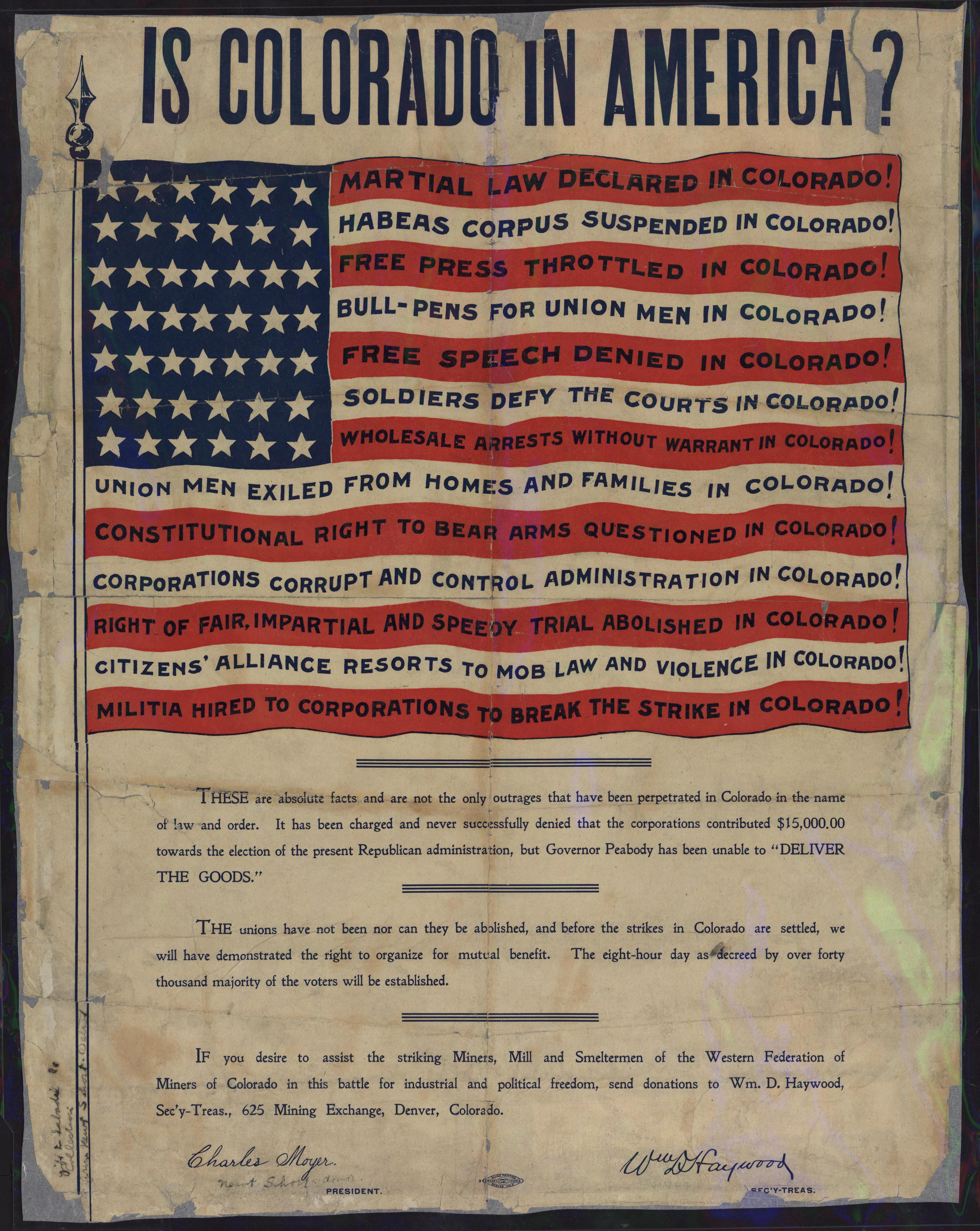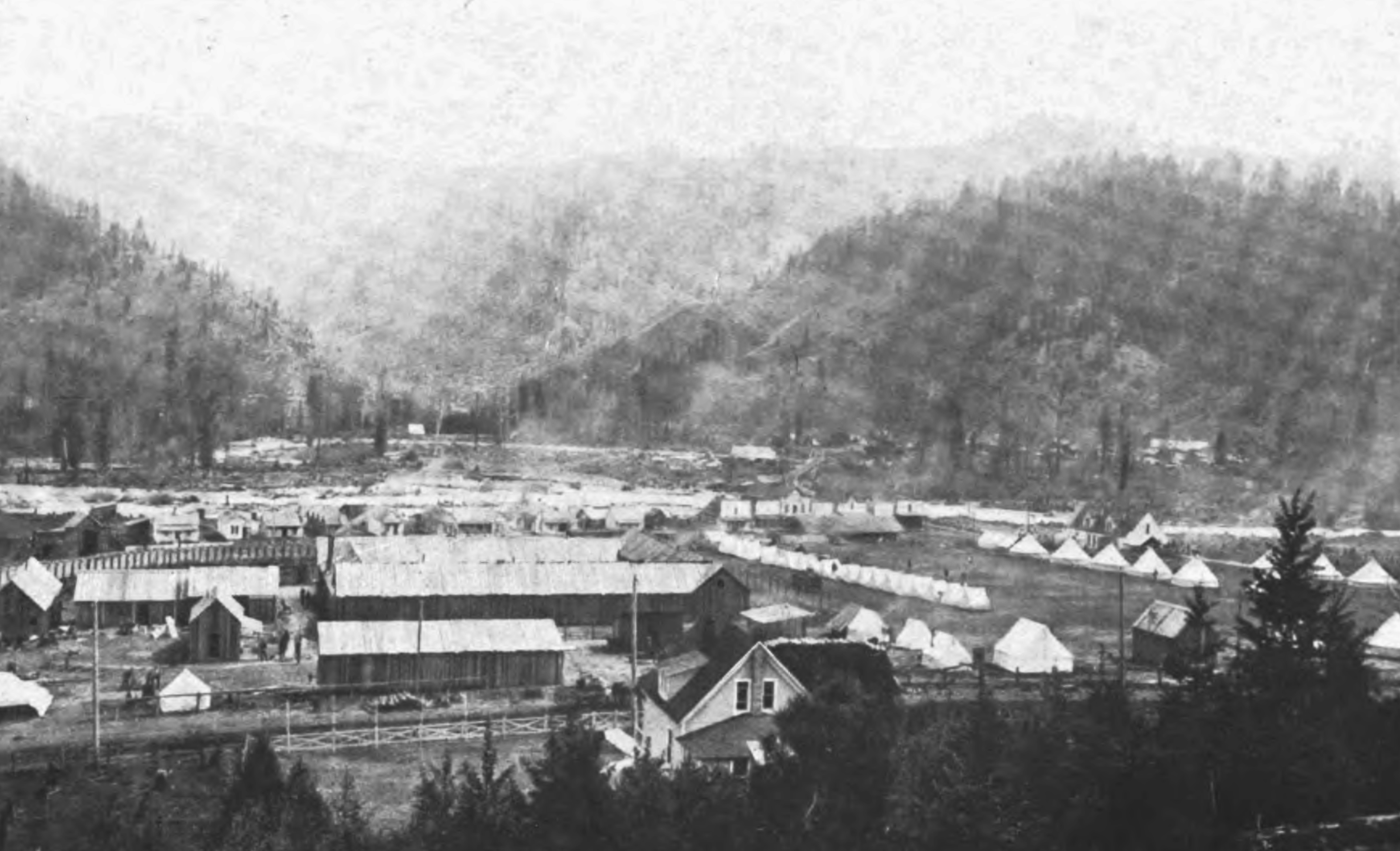|
Butte Miners' Union
The Butte Miners' Union, formerly known as the Butte Workingmen's Union, was formed in 1878 as a reaction to working conditions in the mines of Butte, Montana. Health issues The fatality rate in the Butte mines were higher than Colorado's, Idaho's, and South Dakota's. Mines in Britain and Germany also did not experience such high fatality rates. Annually, 3.35 per 1,000 men were killed in the Montana mines from 1894 to 1908. Men died due to the typical mine accidents such as fires, cave-ins, gassings, and falls, but the greatest threat of all was miners' consumption (medically known as phthisis or Silicosis). In a study of Butte miners from 1916-1919 it was determined that 42% of the workers suffered from miners' consumption. Miners' consumption killed many workers and often led to worse diseases such as tuberculosis and pneumonia. History The poor working conditions pushed the miners to organize, and when the Walker Brothers at the Alice Mine and A.J. Davis at the Lexington min ... [...More Info...] [...Related Items...] OR: [Wikipedia] [Google] [Baidu] |
Western Federation Of Miners
The Western Federation of Miners (WFM) was a labor union that gained a reputation for militancy in the mines of the western United States and British Columbia. Its efforts to organize both hard rock miners and smelter workers brought it into sharp conflicts – and often pitched battles – with both employers and governmental authorities. One of the most dramatic of these struggles occurred in the Cripple Creek district of Colorado in 1903–1904; the conflicts were thus dubbed the Colorado Labor Wars. The WFM also played a key role in the founding of the Industrial Workers of the World in 1905, but left that organization several years later. The WFM changed its name to the International Union of Mine, Mill, and Smelter Workers (more familiarly referred to as Mine Mill) in 1916. After a period of decline it revived in the early days of the New Deal and helped found the Congress of Industrial Organizations (CIO) in 1935. The Mine Mill union was expelled from the CIO in 1950 du ... [...More Info...] [...Related Items...] OR: [Wikipedia] [Google] [Baidu] |
Butte, Montana
Butte ( ) is a consolidated city-county and the county seat of Silver Bow County, Montana, United States. In 1977, the city and county governments consolidated to form the sole entity of Butte-Silver Bow. The city covers , and, according to the 2020 United States Census, 2020 census, has a population of 34,494, making it Montana's List of municipalities in Montana, fifth largest city. It is served by Bert Mooney Airport with airport code BTM. Established in 1864 as a mining camp in the northern Rocky Mountains on the Continental Divide of the Americas, Continental Divide, Butte experienced rapid development in the late-nineteenth century, and was Montana's first major industrial city. In its heyday between the late-nineteenth and early-twentieth centuries, it was one of the largest copper boomtowns in the American West. Employment opportunities in the mines attracted surges of Asian and European immigrants, particularly the Irish people, Irish; as of 2017, Butte has the largest ... [...More Info...] [...Related Items...] OR: [Wikipedia] [Google] [Baidu] |
Phthisis Pulmonalis
Tuberculosis (TB) is an infectious disease usually caused by ''Mycobacterium tuberculosis'' (MTB) bacteria. Tuberculosis generally affects the lungs, but it can also affect other parts of the body. Most infections show no symptoms, in which case it is known as latent tuberculosis. Around 10% of latent infections progress to active disease which, if left untreated, kill about half of those affected. Typical symptoms of active TB are chronic cough with blood-containing mucus, fever, night sweats, and weight loss. It was historically referred to as consumption due to the weight loss associated with the disease. Infection of other organs can cause a wide range of symptoms. Tuberculosis is spread from one person to the next through the air when people who have active TB in their lungs cough, spit, speak, or sneeze. People with Latent TB do not spread the disease. Active infection occurs more often in people with HIV/AIDS and in those who smoke. Diagnosis of active TB is ba ... [...More Info...] [...Related Items...] OR: [Wikipedia] [Google] [Baidu] |
Silicosis
Silicosis is a form of occupational lung disease caused by inhalation of crystalline silica dust. It is marked by inflammation and scarring in the form of nodular lesions in the upper lobes of the lungs. It is a type of pneumoconiosis. Silicosis (particularly the acute form) is characterized by shortness of breath, cough, fever, and cyanosis (bluish skin). It may often be misdiagnosed as pulmonary edema (fluid in the lungs), pneumonia, or tuberculosis. Using workplace controls, silicosis is almost always a preventable disease. Silicosis resulted in at least 43,000 deaths globally in 2013, down from at least 50,000 deaths in 1990. The name ''silicosis'' (from the Latin ''silex'', or flint) was originally used in 1870 by Achille Visconti (1836–1911), prosector in the Ospedale Maggiore of Milan. The recognition of respiratory problems from breathing in dust dates to ancient Greeks and Romans. Agricola, in the mid-16th century, wrote about lung problems from dust inhalation i ... [...More Info...] [...Related Items...] OR: [Wikipedia] [Google] [Baidu] |
Knights Of Labor
Knights of Labor (K of L), officially Noble and Holy Order of the Knights of Labor, was an American labor federation active in the late 19th century, especially the 1880s. It operated in the United States as well in Canada, and had chapters also in Great Britain and Australia. Its most important leader was Terence V. Powderly. The Knights promoted the social and cultural uplift of the worker, and demanded the eight-hour day. In some cases it acted as a labor union, negotiating with employers, but it was never well organized or funded. It was notable in its ambition to organize across lines of gender and race and in the inclusion of both skilled and unskilled labor. After a rapid expansion in the mid-1880s, it suddenly lost its new members and became a small operation again. The Knights of Labor had served, however, as the first mass organization of the white working class of the United States. It was founded by Uriah Stephens on December 28, 1869, reached 28,000 members in 1880, ... [...More Info...] [...Related Items...] OR: [Wikipedia] [Google] [Baidu] |
Bill Haywood
William Dudley "Big Bill" Haywood (February 4, 1869 – May 18, 1928) was an American labor organizer and founding member and leader of the Industrial Workers of the World (IWW) and a member of the executive committee of the Socialist Party of America. During the first two decades of the 20th century, Haywood was involved in several important labor battles, including the Colorado Labor Wars, the Lawrence Textile Strike, and other textile strikes in Massachusetts and New Jersey. Haywood was an advocate of industrial unionism,"New Perspectives on the West – William 'Big Bill' Haywood" PBS.org; retrieved March 20, 2006. a labor philosophy that favors organizing all workers in an industry under one union, regardless of the specific trade or skill level; this was in contrast to the < ... [...More Info...] [...Related Items...] OR: [Wikipedia] [Google] [Baidu] |
Coeur D'Alene, Idaho Labor Confrontation Of 1899
The Coeur d'Alene, Idaho, labor riot of 1899 was the second of two major labor-management confrontations in the Coeur d'Alene mining district of northern Idaho in the 1890s. Like the first incident seven years earlier, the 1899 confrontation was an attempt by union miners, led by the Western Federation of Miners to unionize non-union mines, and have them pay the higher union wage scale. As with the 1892 strike, the 1899 incident culminated in a dynamite attack that destroyed a non-union mining facility, the burning of multiple homes and outbuildings and two murders, followed by military occupation of the district. The riot of 1899 resulted from the miners' frustrations with mine operators that paid lower wages, hired Pinkerton or Thiel operatives to infiltrate the union, and the refusal of non-union miners to join or strike. Background Miners strike of 1892 Angered by wage cuts, Coeur d'Alene area miners conducted a strike in 1892. The strike erupted in violence when union m ... [...More Info...] [...Related Items...] OR: [Wikipedia] [Google] [Baidu] |
Mining Trade Unions
Mining is the extraction of valuable minerals or other geological materials from the Earth, usually from an ore body, lode, vein, seam, reef, or placer deposit. The exploitation of these deposits for raw material is based on the economic viability of investing in the equipment, labor, and energy required to extract, refine and transport the materials found at the mine to manufacturers who can use the material. Ores recovered by mining include metals, coal, oil shale, gemstones, limestone, chalk, dimension stone, rock salt, potash, gravel, and clay. Mining is required to obtain most materials that cannot be grown through agricultural processes, or feasibly created artificially in a laboratory or factory. Mining in a wider sense includes extraction of any non-renewable resource such as petroleum, natural gas, or even water. Modern mining processes involve prospecting for ore bodies, analysis of the profit potential of a proposed mine, extraction of the desired materials, and ... [...More Info...] [...Related Items...] OR: [Wikipedia] [Google] [Baidu] |
Trade Unions Established In 1885
Trade involves the transfer of goods and services from one person or entity to another, often in exchange for money. Economists refer to a system or network that allows trade as a market. An early form of trade, barter, saw the direct exchange of goods and services for other goods and services, i.e. trading things without the use of money. Modern traders generally negotiate through a medium of exchange, such as money. As a result, buying can be separated from selling, or earning. The invention of money (and letter of credit, paper money, and non-physical money) greatly simplified and promoted trade. Trade between two traders is called bilateral trade, while trade involving more than two traders is called multilateral trade. In one modern view, trade exists due to specialization and the division of labour, a predominant form of economic activity in which individuals and groups concentrate on a small aspect of production, but use their output in trades for other products ... [...More Info...] [...Related Items...] OR: [Wikipedia] [Google] [Baidu] |
Trade Unions In Montana
Trade involves the transfer of goods and services from one person or entity to another, often in exchange for money. Economists refer to a system or network that allows trade as a market. An early form of trade, barter, saw the direct exchange of goods and services for other goods and services, i.e. trading things without the use of money. Modern traders generally negotiate through a medium of exchange, such as money. As a result, buying can be separated from selling, or earning. The invention of money (and letter of credit, paper money, and non-physical money) greatly simplified and promoted trade. Trade between two traders is called bilateral trade, while trade involving more than two traders is called multilateral trade. In one modern view, trade exists due to specialization and the division of labour, a predominant form of economic activity in which individuals and groups concentrate on a small aspect of production, but use their output in trades for other products and ... [...More Info...] [...Related Items...] OR: [Wikipedia] [Google] [Baidu] |

.jpg)







